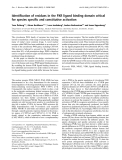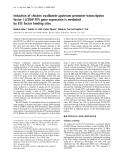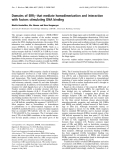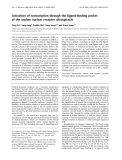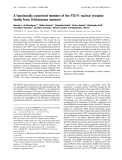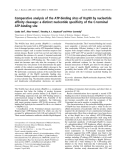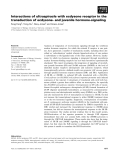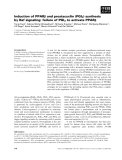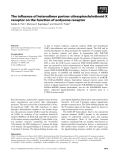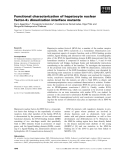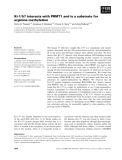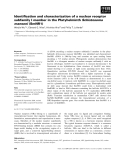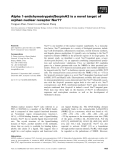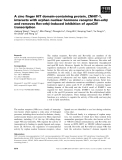
Nuclear receptor
-
Nuclear receptors (NRs) are ligand-regulated, DNA-binding transcription factors that function in the chromatin environment of the nucleus to alter the expression of subsets of hormone-responsive genes. It is clear that chromatin, rather than being a passive player, has a profound effect on both transcriptional repression and activation mediated by NRs.
 9p
9p  research12
research12
 01-06-2013
01-06-2013
 32
32
 2
2
 Download
Download
-
The cytochrome P450 family of enzymes has long been known tometabolize a wide range of compounds, including many of today’s most common drugs. A novel nuclear receptor called PXR has been established as an activator of several of the cytochrome P450 genes, including CYP3A4. This enzyme is believed to account for the metabolism of more than 50% of all prescription drugs. PXR is therefore used as a negative selector target and discriminatory filter in preclinical drug development.
 9p
9p  research12
research12
 29-04-2013
29-04-2013
 44
44
 3
3
 Download
Download
-
Chickenovalbuminupstreampromoter-transcriptionfactorI (COUP-TFI, or NR2F1) is an orphan nuclear receptor that plays amajor role in the development of the nervous system. We show here that three ETS response elements in the COUP-TFIpromoter mediate its transcription. A reporter gene containing theseETSbinding sites is activatedbyEts-1, while the same reporter with point mutations on all three ETS response elements is not.
 9p
9p  research12
research12
 29-04-2013
29-04-2013
 28
28
 3
3
 Download
Download
-
The estrogen receptor-related receptorc (ERRc/ERR3/ NR3B3) is an orphan member of the nuclear receptor superfamily closely related to the estrogen receptors. To explore the DNA binding characteristics, the protein–DNA interaction was studied in electrophoretic mobility shift assays (EMSAs). In vitro translated ERRc binds as a homodimer to direct repeats (DR) without spacing of the nuclear receptor half-site 5¢-AGGTCA-3¢(DR-0), to exten-dedhalf-sites, and to the inverted estrogen response element....
 12p
12p  research12
research12
 23-04-2013
23-04-2013
 23
23
 3
3
 Download
Download
-
The invertebrate nuclear receptor, ultraspiracle (USP), an ortholog of the vertebrate RXR, is typically modelled as an orphan receptor that functions without a ligand-binding activity. The identification of a ligand that can transcrip-tionally activate USP would provide heuristic leads to the structure of potentially high affinity activating compounds, with which to detect unknown regulatory pathways in which this nuclear receptor participates.
 11p
11p  tumor12
tumor12
 22-04-2013
22-04-2013
 40
40
 2
2
 Download
Download
-
Thefushi tarazu factor 1 (FTZ-F1) nuclear receptor sub-family comprises orphan receptors with crucial roles in development and sexual differentiation in vertebrates and invertebrates. We describe the structure and functional properties of an FTZ-F1 from the platyhelminth parasite of humans,Schistosoma mansoni, the first receptor from this family tobe characterized inaLophotrochozoan. It contains awell conservedDNA-binding domain (55–63%identity to other family members) and a poorly conserved ligand-binding domain (20% identity to that of zebrafish FF1a)....
 12p
12p  tumor12
tumor12
 22-04-2013
22-04-2013
 47
47
 2
2
 Download
Download
-
The 90-kDa heat shock protein (Hsp90) is a molecular chaperone that assists both in ATP-independent sequestra-tion of damaged proteins, and inATP-dependent folding of numerous targets, such as nuclear hormone receptors and protein kinases. Recent work from our lab and others has established the existence of a second, C-terminal nucleotide bindingsite besides the well characterized N-terminal, gel-danamycin-sensitive ATP-bindingsite.
 8p
8p  fptmusic
fptmusic
 16-04-2013
16-04-2013
 33
33
 4
4
 Download
Download
-
Analyses of integration of two-hormone signaling through the vertebrate nuclear hormone receptors, for which the retinoid X receptor is one part-ner, have generated a number of mechanistic models, including those des-cribed as ‘subordination’ models wherein ligand-activation of one partner is subordinate to the liganded state of the other partner.
 13p
13p  awards
awards
 06-04-2013
06-04-2013
 19
19
 3
3
 Download
Download
-
Retinoid receptors are ligand-dependent transcription factors belonging to the nuclear receptor superfamily. Retinoic acid (RARa, b, c) and retinoid X (RXRa, b, c) receptors mediate the retinoid/rexinoid signal to the transcriptional machineries by interacting at the first level with coactivators or corepressors, which leads to the recruitment of enzymatically active noncovalent com-plexes at target gene promoters.
 10p
10p  awards
awards
 05-04-2013
05-04-2013
 35
35
 4
4
 Download
Download
-
We previously identified a partial expressed sequence tag clone corresponding toNARG2in a screen for genes that are expressed in developing neurons and misexpressed in transgenic mice that lack functional N-methyl-D-aspartate receptors. Here we report the first characterization of the mouse and humanNARG2genes, cDNAs and the proteins that they encode.Mouse andhumanNARG2 consist of 988 and 982 amino acids, respectively, and share 74% identity.
 9p
9p  awards
awards
 05-04-2013
05-04-2013
 43
43
 2
2
 Download
Download
-
Peroxisome proliferator-activated receptora(PPARa) is thought to play an important role in lipid metabolism in the liver. To clarify the extra-hepatic and⁄or unknown function of PPARa, we previously performed a proteome analysis of the intestinal proteins and identified 17b-hydroxyster-
 9p
9p  dell39
dell39
 27-03-2013
27-03-2013
 33
33
 3
3
 Download
Download
-
A role for the nuclear receptor peroxisome proliferator-activated recep-tor-b(PPARb) in oncogenesis has been suggested by a number of obser-vations but its precise role remains elusive. Prostaglandin I2 (PGI2 , prostacyclin), a major arachidonic acid (AA) derived cyclooxygenase (Cox) product, has been proposed as a PPARbagonist.
 10p
10p  dell39
dell39
 27-03-2013
27-03-2013
 40
40
 3
3
 Download
Download
-
A pair of nuclear receptors, ecdysone receptor (EcR) and ultraspiracle (USP), heterodimerize and transduce ecdysteroid signals. The EcR and its nonsteroidal ligands are being developed for regulation of transgene expres-sion in humans, animals and plants. In mammalian cells, EcR:USP heterodimers can function in the absence of ligand, but EcR⁄retinoid X receptor (EcR:RXR) heterodimers require the presence of ligand for activa-tion.
 12p
12p  dell39
dell39
 27-03-2013
27-03-2013
 43
43
 4
4
 Download
Download
-
Hepatocyte nuclear factor-4 (HNF-4a), a member of the nuclear receptor superfamily, binds DNA exclusively as a homodimer. Dimerization con-trols important aspects of receptor function, such as DNA binding, protein stability, ligand binding and interaction with coactivators.
 11p
11p  inspiron33
inspiron33
 26-03-2013
26-03-2013
 47
47
 5
5
 Download
Download
-
The human 57 kDa Ki-1 antigen (Ki-1⁄57) is a cytoplasmic and nuclear protein, associated with Ser⁄Thr protein kinase activity, and phosphorylat-ed at the serine and threonine residues upon cellular activation. We have shown that Ki-1⁄57 interacts with chromo-helicase DNA-binding domain protein 3 and with the adaptor⁄signaling protein receptor of activated kinase 1 in the nucleus.
 16p
16p  inspiron33
inspiron33
 25-03-2013
25-03-2013
 35
35
 4
4
 Download
Download
-
The steroid hormone 20-hydroxyecdysone (20E) initiates insect molting and metamorphosis through binding with a heterodimer of two nuclear recep-tors, the ecdysone receptor (EcR) and ultraspiracle (USP). Expression of the specific isoforms EcR-A and EcR-B1 governs steroid-induced responses in the developing cells of the silkworm Bombyx mori.
 8p
8p  inspiron33
inspiron33
 25-03-2013
25-03-2013
 48
48
 5
5
 Download
Download
-
A cDNA encoding a nuclear receptor subfamily I member in the platy-helminthSchistosoma mansoni(SmNR1) was identified and characterized. SmNR1 cDNA is 2406 bp long and contains an open reading frame encoding a 715 residue protein.
 16p
16p  inspiron33
inspiron33
 23-03-2013
23-03-2013
 37
37
 4
4
 Download
Download
-
Nur77 is one member of the nuclear receptor superfamily. As a transcrip-tion factor, Nur77 participates in a variety of biological processes, includ-ing T cell development, inflammatory responses, steroid hormone synthesis, and hepatic glucose metabolism. It typically acts via binding to the Nur77 responsive element (NBRE) in the promoter regions of its target genes.
 14p
14p  media19
media19
 06-03-2013
06-03-2013
 48
48
 4
4
 Download
Download
-
Bisphenol A, 2,2-bis(4-hydroxyphenyl)propane, is an estrogenic endocrine disruptor that influences various physiological functions at very low doses, even though bisphenol A itself is ineffectual as a ligand for the estrogen receptor.
 12p
12p  media19
media19
 05-03-2013
05-03-2013
 50
50
 2
2
 Download
Download
-
The orphan receptors, Rev-erba and Rev-erbb, are members of the nuclear receptor superfamily and specifically repress apolipoprotein CIII (apoCIII) gene expression in rats and humans. Moreover, Rev-erbanull mutant mice have elevated very low density lipoprotein triacylglycerol and apoCIII levels.
 12p
12p  media19
media19
 04-03-2013
04-03-2013
 36
36
 2
2
 Download
Download
CHỦ ĐỀ BẠN MUỐN TÌM










